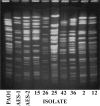Phenotypic characterization of clonal and nonclonal Pseudomonas aeruginosa strains isolated from lungs of adults with cystic fibrosis
- PMID: 17392437
- PMCID: PMC1933084
- DOI: 10.1128/JCM.02364-06
Phenotypic characterization of clonal and nonclonal Pseudomonas aeruginosa strains isolated from lungs of adults with cystic fibrosis
Abstract
The emergence of virulent Pseudomonas aeruginosa clones is a threat to cystic fibrosis (CF) patients globally. Characterization of clonal P. aeruginosa strains is critical for an understanding of its clinical impact and developing strategies to meet this problem. Two clonal strains (AES-1 and AES-2) are circulating within CF centers in eastern Australia. In this study, phenotypic characteristics of 43 (14 AES-1, 5 AES-2, and 24 nonclonal) P. aeruginosa isolates were compared to gain insight into the properties of clonal strains. All 43 isolates produced bands of the predicted size in PCRs for vfr, rhlI, rhlR, lasA, lasB, aprA, rhlAB, and exoS genes; 42 were positive for lasI and lasR, and none had exoU. Thirty-seven (86%) isolates were positive in total protease assays; on zymography, 24 (56%) produced elastase/staphylolysin and 22 (51%) produced alkaline protease. Clonal isolates were more likely than nonclonal isolates to be positive for total proteases (P = 0.02), to show elastase and alkaline protease activity by zymography (P = 0.04 and P = 0.01, respectively), and to show elastase activity by the elastin-Congo red assay (P = 0.04). There were no other associations with genotype. Overall, increasing patient age was associated with decreasing elastase activity (P = 0.03). Thirty-two (74%) isolates had at least one N-acylhomoserine lactone (AHL) by thin-layer chromatography. rhl-associated AHL detection was associated with the production and level of total protease and elastase activity (all P < 0.01). Thirty-three (77%) isolates were positive for ExoS by Western blot analysis, 35 (81%) produced rhamnolipids, and 34 (79%) showed chitinase activity. Findings suggest that protease activity during chronic infection may contribute to the transmissibility or virulence of these clonal strains.
Figures



References
-
- Anthony, M., B. Rose, M. B. Pegler, M. Elkins, H. Service, K. Thamotharampillai, J. Watson, M. Robinson, P. Bye, J. Merlino, and C. Harbour. 2002. Genetic analysis of Pseudomonas aeruginosa isolates from the sputa of Australian adult cystic fibrosis patients. J. Clin. Microbiol. 40:2772-2778. - PMC - PubMed
-
- Armstrong, D., S. Bell, M. Robinson, P. Bye, B. Rose, C. Harbour, C. Lee, H. Service, M. Nissen, M. Syrmis, and C. Wainwright. 2003. Evidence for patient-to-patient spread of a clonal strain of Pseudomonas aeruginosa in different cystic fibrosis clinics in Australia. J. Clin. Microbiol. 41:2266-2267. - PMC - PubMed
-
- Armstrong, D., G. M. Nixon, R. Carzino, A. Bigham, J. B. Carlin, R. M. Robins-Browne, and K. Grimwood. 2002. Detection of a widespread clone of Pseudomonas aeruginosa in a pediatric cystic fibrosis clinic. Am. J. Respir. Crit. Care Med. 166:983-987. - PubMed
-
- Caballero, A. R., J. M. Moreau, L. S. Engel, M. E. Marquart, J. M. Hill, and R. J. O'Callaghan. 2001. Pseudomonas aeruginosa protease IV enzyme assays and comparison to other Pseudomonas proteases. Anal. Biochem. 290:330-337. - PubMed
-
- Chambers, C. E., M. B. Visser, U. Schwab, and P. A. Sokol. 2005. Identification of N-acylhomoserine lactones in mucopurulent respiratory secretions from cystic fibrosis patients. FEMS Microbiol. Lett. 244:297-304. - PubMed
Publication types
MeSH terms
Substances
LinkOut - more resources
Full Text Sources
Medical
Molecular Biology Databases

